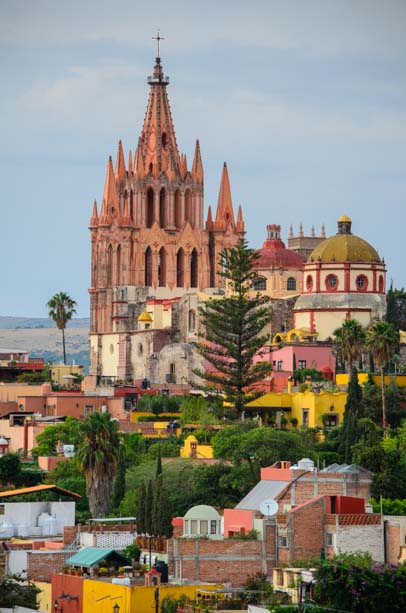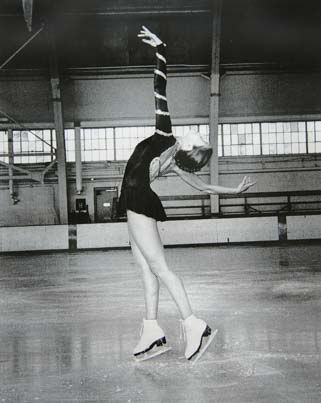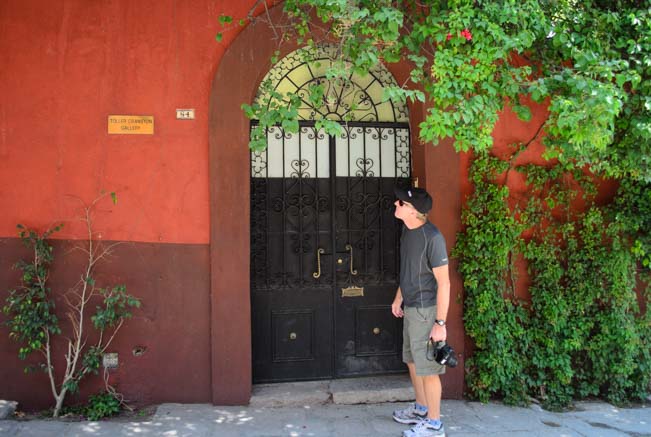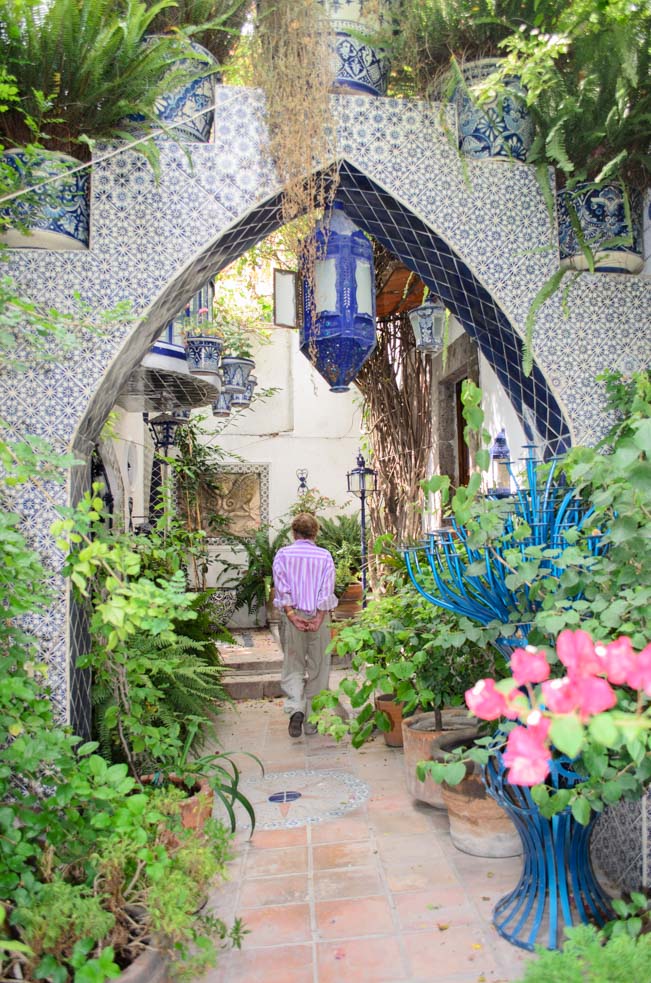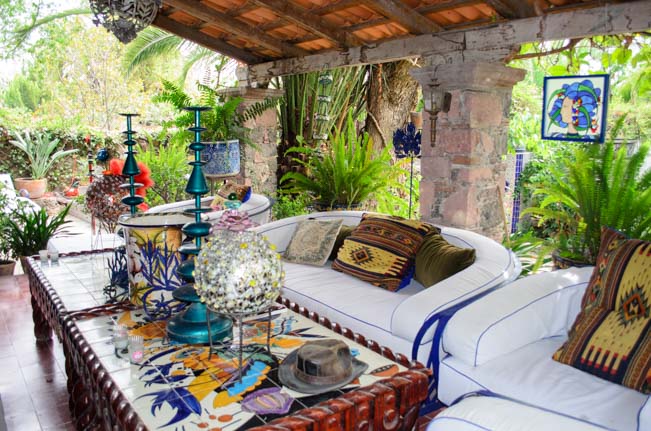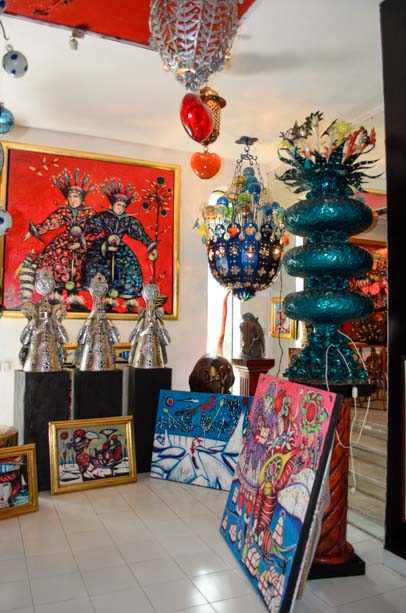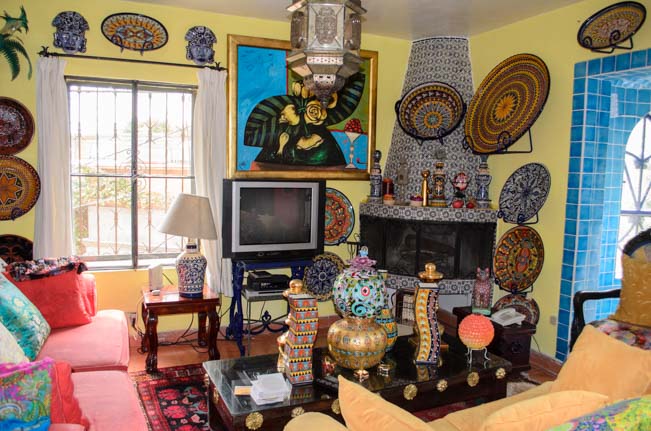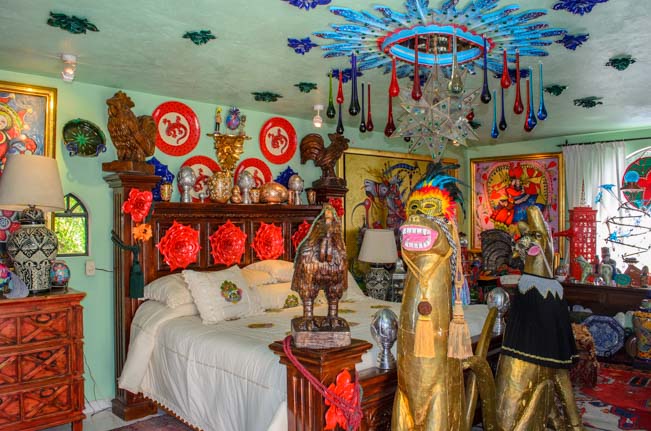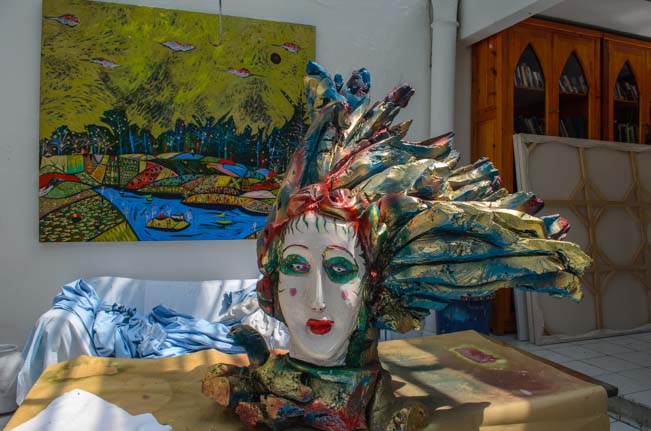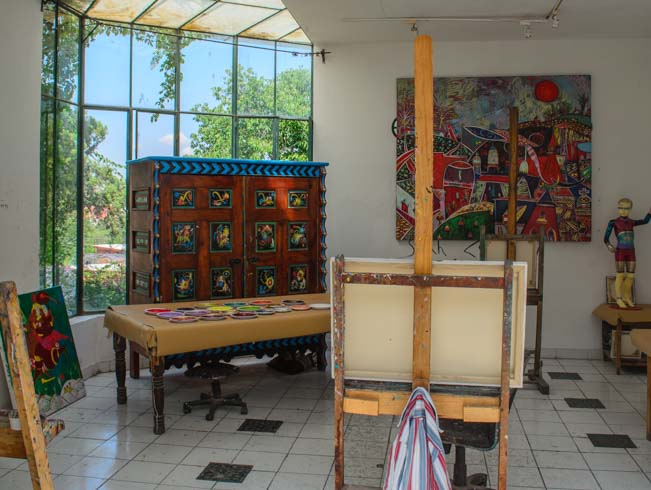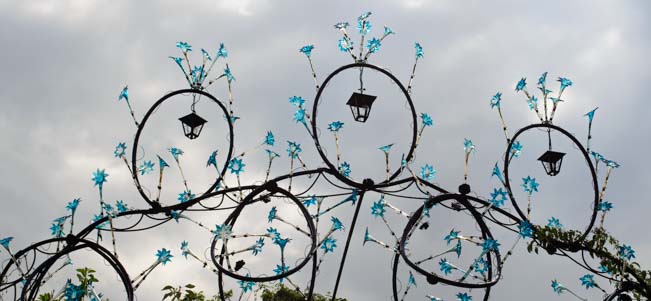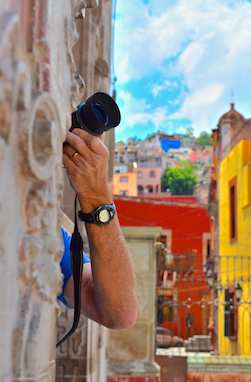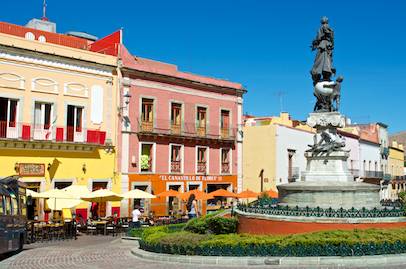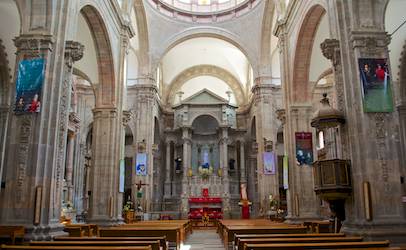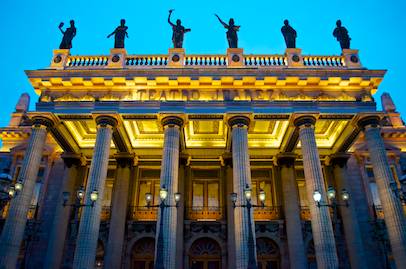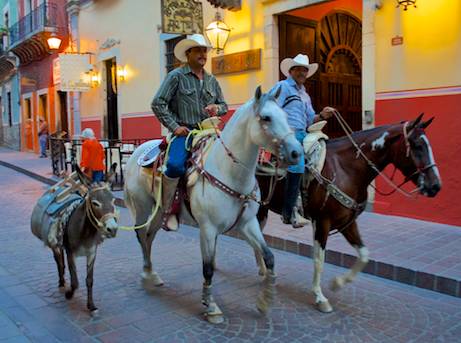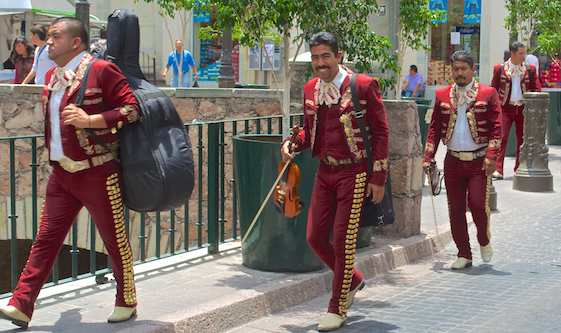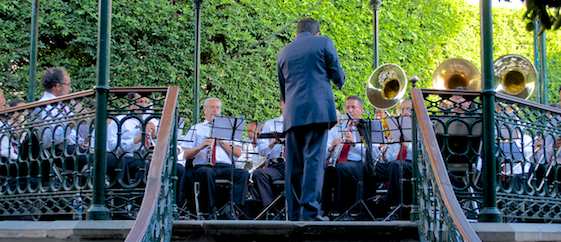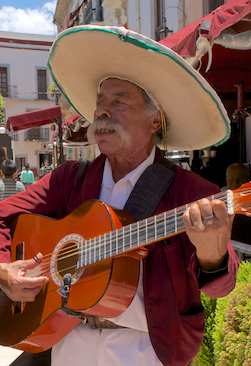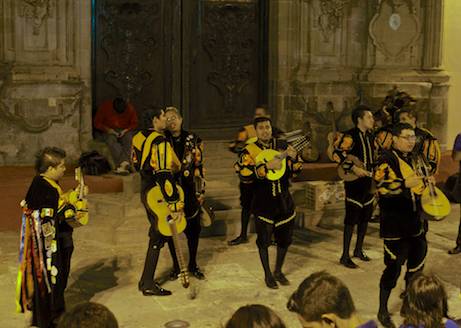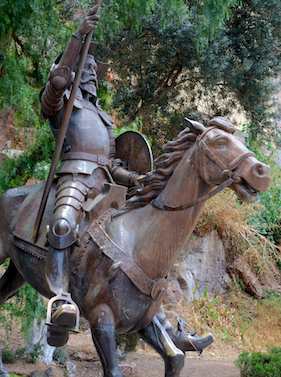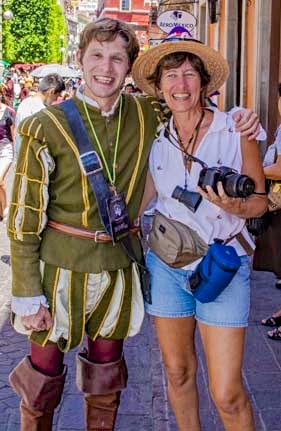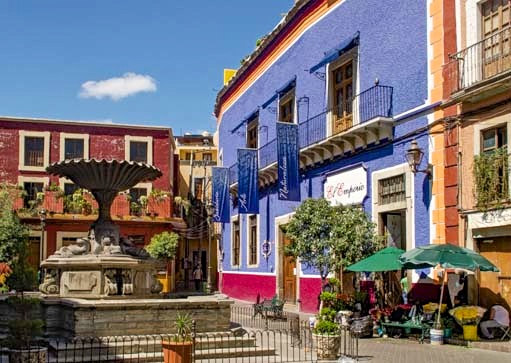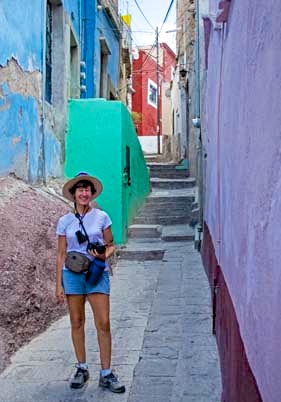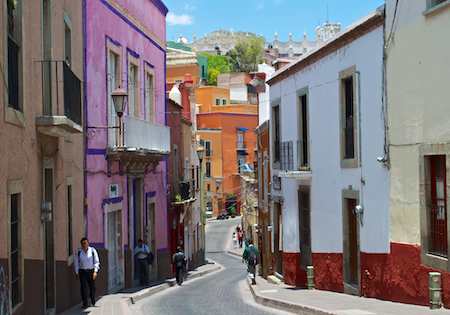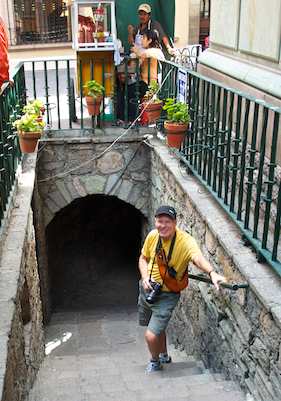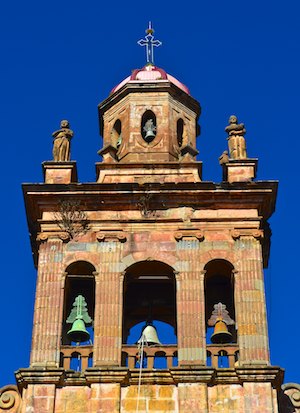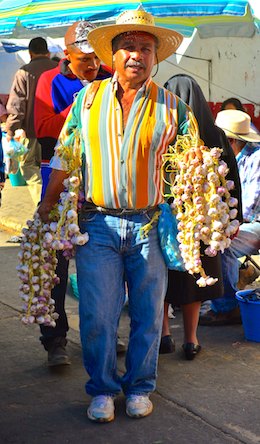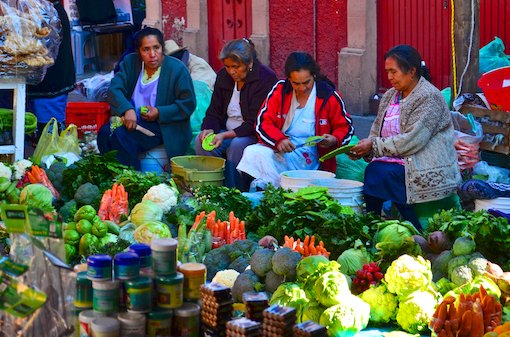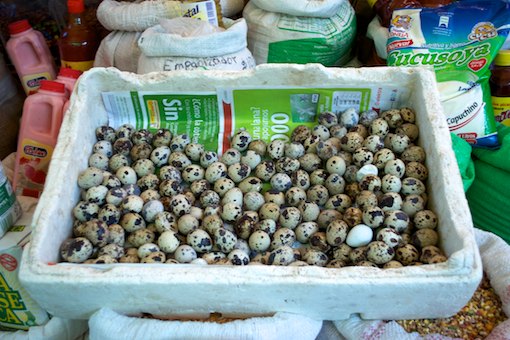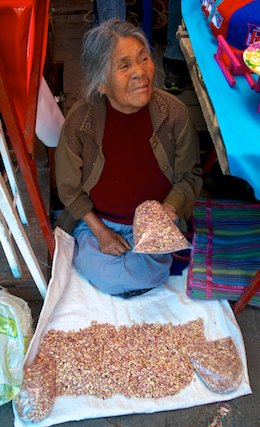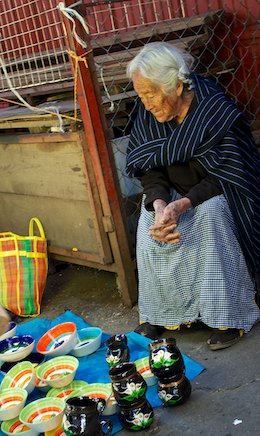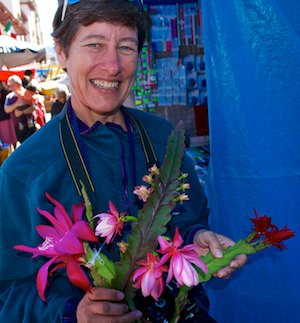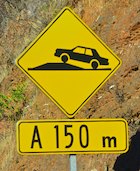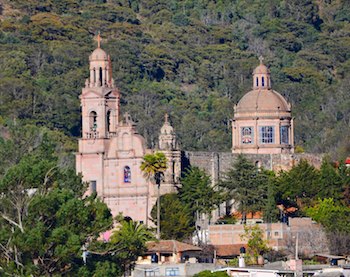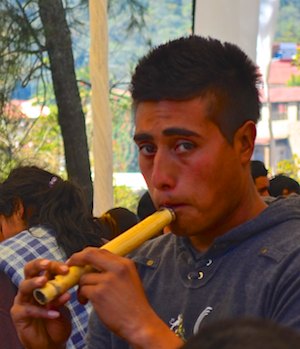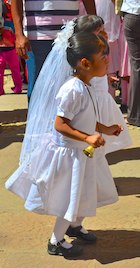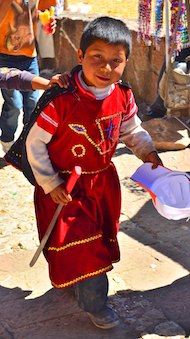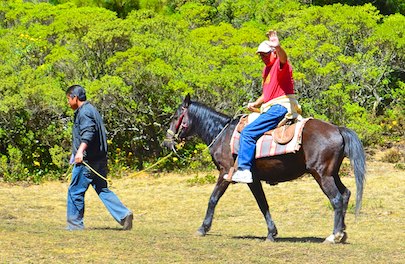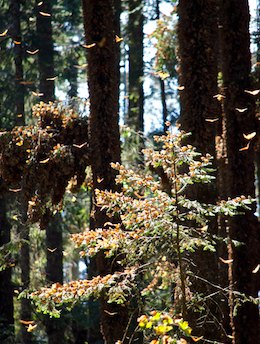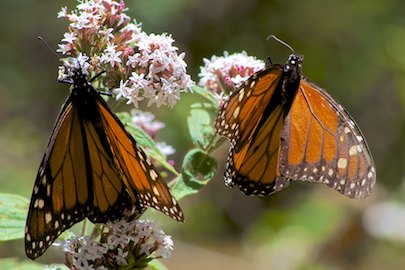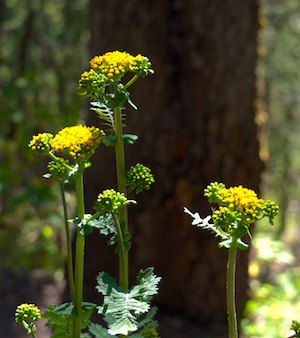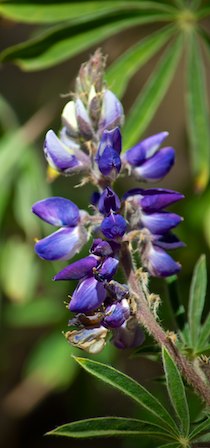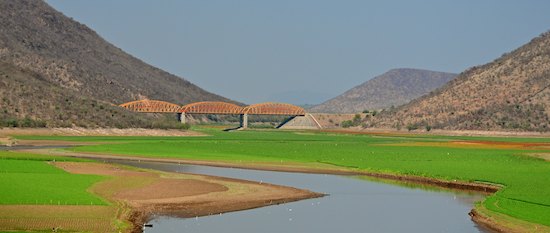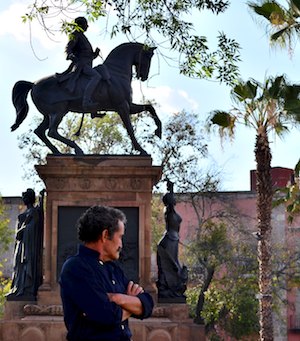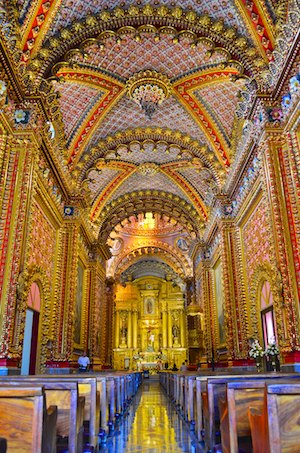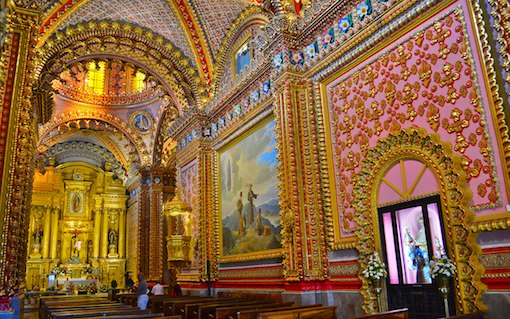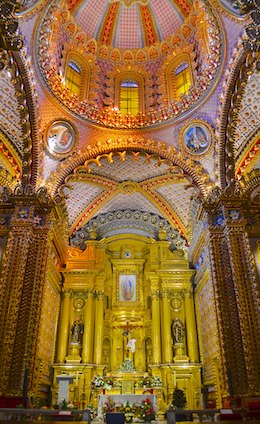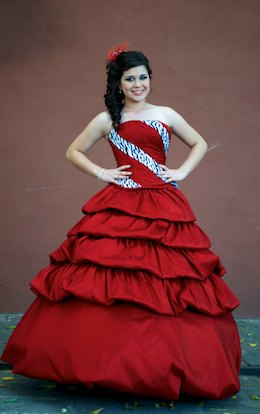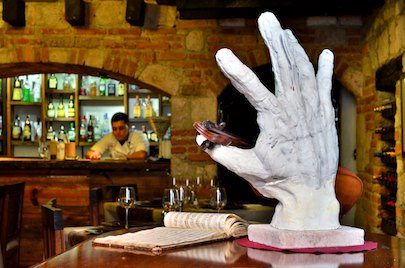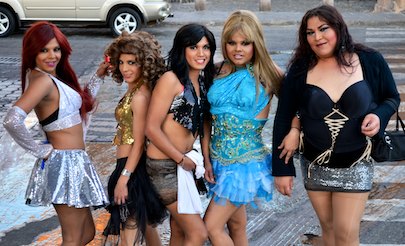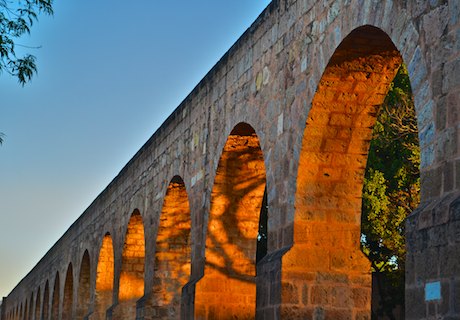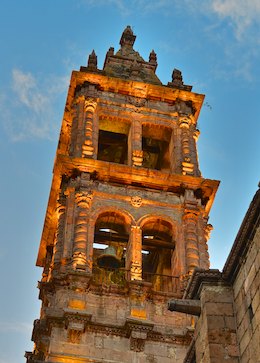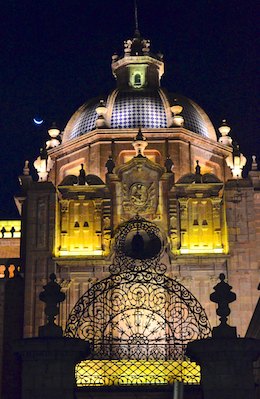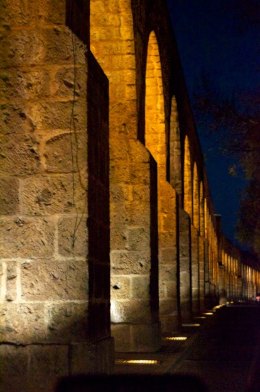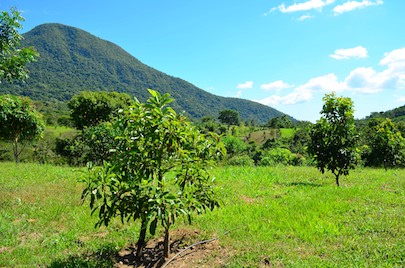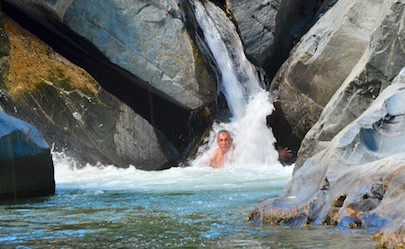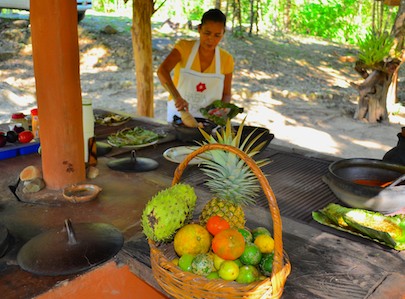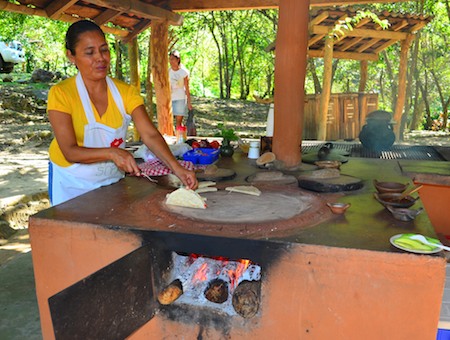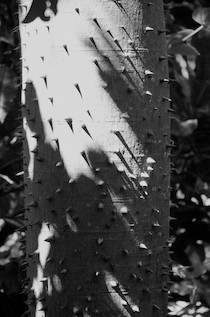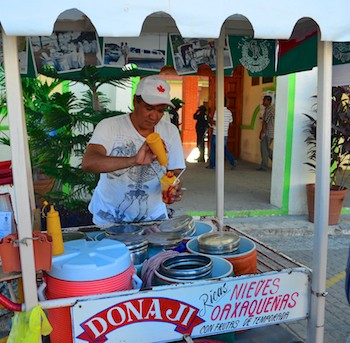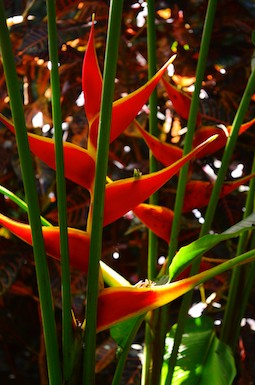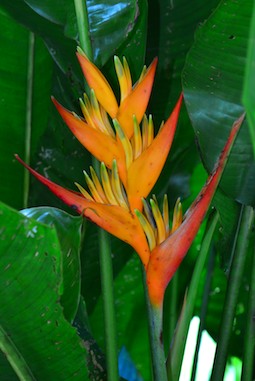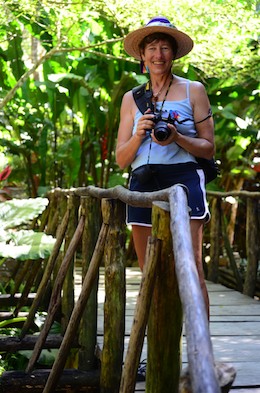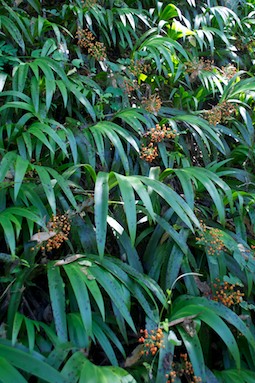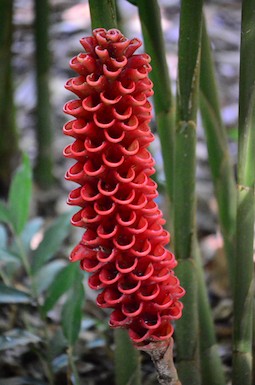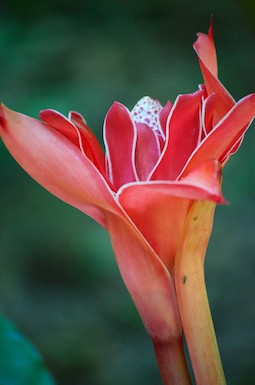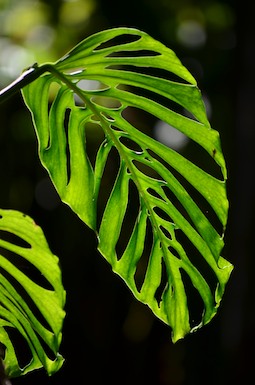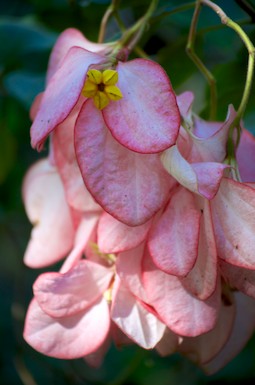A trip to the dentist’s office isn’t fun for anyone anywhere, but Mexican dentists do terrific work, and we have received outstanding and very affordable dental care in our travels throughout Mexico, both on our sailboat and in our RV.
This page offers a glimpse of what a trip to a Mexican dentist’s office is like, what to expect when crossing the border to get dental work done, which dentists we’ve been to and recommend, and what various dental procedures have cost us. There’s a ton of info on Mexican dentistry here, and if you don’t want to read it all in one sitting, these quick links will get where you want to go:
- Getting a crown — our experience
- Where are Mexican dentists trained, do they speak English, and why are they so cheap?
- Getting a root canal — our experience
- Tips for finding and going to the dentist in Mexico
- Dentists we’ve been to and recommend
- Typical dental costs and where it’s cheapest
- Make a day of it and have some fun!
Getting a Crown in Mexico — Our Experience in San Luis south of Yuma, AZ
Our first experience with a Mexican dentist, and the one that totally changed our attitude towards Mexican dentistry in general, was in San Luis Mexico, just a little south of Yuma, Arizona, back in 2008.

Getting a Mexican Crown was quite an adventure for us back in the day.
We walked over the border and continued on for half a block to the office of Dr. Sergio Bernal at 4:00 on a Friday afternoon. We did not have an appointment, but we wanted to see what could be done about a baby tooth of Mark’s that had never fallen out but had suddenly started bothering him.
After two minutes in the chair, Dr. Bernal recommended he get a crown. We weren’t sure about getting something complicated like this done in Mexico, and were also unsure whether a gold crown or porcelain crown would be preferable. We walked around the streets of San Luis for an hour debating whether to go for it, and if so, what kind of crown to get.
When we returned to Dr. Bernal’s office, we met a group of Americans from Las Vegas in the waiting room. A big friendly guy in the group told us he gathered up his friends and family every year, rented a car, and drove down to San Luis to get their teeth checked and worked on by Dr. Bernal. He’d had extensive bridge work done by Dr. Bernal 10 years prior, and he had been so impressed by the quality and affordable cost of the job that he’d been going back ever since.
Mark decided to go for it, and in no time Dr. Bernal had ground down his tooth, made an impression of it and made arrangements for a porcelain crown to be delivered to his office by noon the next day. Because the permanent crown would be installed so soon, there was no need for a temporary crown (how nice!).
As we walked out the door (without having paid a cent for the diagnosis, the tooth grinding or the impression), Dr. Bernal asked Mark his name, scribbled it on a yellow sticky pad and put it on the impression. He waved to us as we left to walk back over the border and said, “See you tomorrow!”
Despite the next day being a Saturday (we later learned Mexicans work six days a week), we walked across the border again at noon, and Dr. Bernal quickly cemented the crown in place.
The cost? $130 US.
Best of all, it was a perfect color match and was the best fitting crown Mark had ever had. It has been fine ever since.
From that moment on, we have entrusted our teeth to Mexican dentists throughout the country without a moment’s hesitation.

The Dentist Chair… yikes!
During our nearly four year cruise of Mexico on our sailboat, we visited dentists (and doctors) up and down the Pacific coast and in the Sea of Cortez. The dental care was always top quality, very caring, and very affordable. We have never had unnecessary work recommended (as happened to me 15 years ago in the US when an unscrupulous dentist recommended I get five crowns immediately, only one of which I actually needed).
I always feel like going to the dentist in Mexico is basically like going to the barber. You walk in off the street without an appointment, talk to the dentist directly, hop in the chair for him or her to assess what you need, get it done right away or return the next day, and walk out with everything completed at a fraction of what it would cost in the US.
Where Are Mexican Dentists Trained?
There are some urban myths about Mexican dentistry. I’ve heard people say, “The best Mexican dentists get their training in the US.”
In our experience, that is not true. Of the ten excellent dentists and doctors we have been to in Mexico, none received their training in an American university.
Usually, Mexican dentists and doctors hang their diplomas on the wall. Whether the diplomas are hand calligraphed in Latin or typed up in Spanish, it is pretty easy to tell if the university was in Guadalajara, Mexico City or Baja California (the three areas for medical and dental schools we’ve seen on diplomas).
Do Mexican Dentists Speak English?
In our experience, most speak at least a little, especially in tourist areas and in the border towns where a lot of Americans come specifically to receive dental care.
Why Are Mexican Dentists So Cheap?
People also wonder how it is that Mexican dental (and medical) professionals can charge so little for their services if they are really as good as (or better than) their counterparts in the US. The reasons are complex, but in a nutshell, the American and Mexican economies and cultures are totally different. Even more important, the business models for the dental and medical professions are not at all alike in the two countries.
A Lower Wage Scale in Mexico
The average DAILY wage for an unskilled Mexican worker is around $5 per DAY. Obviously, skilled workers make more, but the entire spectrum of wages, from professionals to janitors, is scaled down much lower than the US. In many cases, like that of a city employed street sweeper we met in Huatulco, the employee provides the equipment for their job. This industrious city worker we met had fashioned his brooms for his government job from tree branches and twigs himself.
Cheaper Office Space
Commercial property rental is also much cheaper. A friend of mine who owns a store in the popular seaside tourist town of Zihuatanejo pays $30 a MONTH to rent the space. Office space for Mexican dentists and doctors may not be quite that low, but even if it is double the price, it is still negligible by American standards.
Very Little or No Staff
Mexican dentists and doctors also don’t employ much staff, if any. Some dentists have an assistant, but many of the best ones we’ve been to don’t. Also, there is no one dedicated to answering the phone and making appointments. Any time we have had our teeth cleaned, it was done by the dentist and not by a hygienist. One very conscientious dentist spent an HOUR cleaning my teeth and then spent another HOUR on Mark’s, for $45 US each.
Little or No Malpractice Insurance and Marketing
Unlike their American counterparts, Mexican dentists and doctors don’t have to carry massive amounts malpractice insurance. Also, they don’t invest in marketing. None of the dentists we’ve been to have websites, and it is very difficult to find information about any of them on the internet. The few Mexican dentists that do have websites cater primarily to Americans, and we found that their fees are often adjusted upwards accordingly.
No Third Party Relationships
Mexican dentists and doctors also set their fees according to the market demands of their patients. There is no insurance company operating as a middle man. Patients pay their medical providers directly rather than paying an insurance company who, in turn, then pays the dentist or doctor, as happens in the US.
This keeps the patient/doctor relationship very pure. The doctor or dentist is employed by the patient, not by a third party insurance company. Fees for unexpected issues that come up requiring return visits, extra x-rays, additional prescriptions, etc., can be discussed between doctor/dentist and patient. In our experience, though, those little extras have been free because the dentist/doctor is managing the relationship with the patient/customer and wants to provide good value.
Getting A Root Canal in Mexico — Our Experience in San Luis south of Yuma, AZ
A few weeks ago one of my teeth began to bother me, so we decided to return to our dentist, Dr. Sergio Bernal, in San Luis, Mexico, who had done such a fine job with Mark’s crown years ago. We took our rig to Yuma, drove our truck to the Mexican border and parked it in a parking lot on the American side right next to the border crossing area. The parking fee was $4 for 24 hours (in 2017 it is $5 for 24 hours).

The parking lot on the American side of the border at San Luis, Arizona. $4 for 24 hours.
It was 8:45 in the morning on a Tuesday, and we followed signs that walked us through the border crossing. We saw a few Mexican border agents, but none asked for our passports. Then we emerged on the other side and saw a soldier dressed in desert camo holding an automatic weapon.
The soldier smiled broadly at us when we said “buenos días” to him as we passed by, and he said “buenos días” to us in return.
Having lived in Mexico for a few years, we learned that Mexicans always greet each other with a warm “buenos días” (before noon), or “buenas tardes” (after 12:00 p.m. – sharp), whether they are passing in the street, or standing in front of a store clerk about to pay for something, or boarding a crowded bus (everyone on the bus responds!). Mustering the guts to say that phrase in Mexico will always get you a smiling response, and it is heartwarming and fun to give it a try.
We also learned that the presence of soldiers is just standard procedure at Mexico’s borders (we’ve seen them at the US and Guatemala borders). It is also standard procedure when the Mexican Navy boards boats at sea.
Our sailboat was boarded 8 times during our cruise, either to to check our papers, to check for weapons and drugs, or to make sure we had proper safety gear on board. Each time the inspectors couldn’t have been nicer or more polite. In one case, when they brought aboard a drug-sniffing dog, they put booties on his feet so he wouldn’t scratch the boat. Another time we were given a performance evaluation form to fill out for the boss!
I touch on three of the Mexican Navy boardings we experienced in these blog posts:
Moments after crossing the border, we emerged onto a lively and busy street in the town of San Luis Rio Colorado, the Mexican sister city of San Luis, Arizona.
After emerging from the border complex, we walked straight down the street, crossing a small intersection and looking to our left towards the opposite side of the street as we walked.
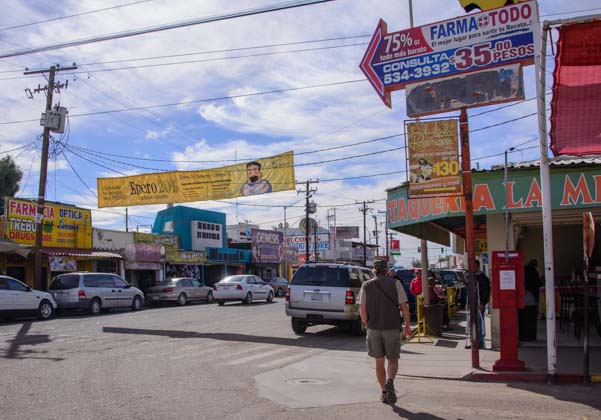
Mark crosses a small intersection after crossing the border.
Dr. Bernal’s office is on the left just beyond the lavender “Genesis” sign (center of photo).
We were walking south on First Street (“Calle 1”). Dr. Bernal’s office is in an alcove on east side of the street (the opposite side…the left side in the above photo) about halfway between the first intersection we had just crossed and the street light at the next intersection.
The shops are small and tightly packed with colorful but faded signs overhead.

Walking down Calle 1 (1st Street), and looking left, these shops are just before Dr. Bernal’s alcove.
Catching sight of the lavender “Genesis” sign on the left side (east side) of the street, we spotted the alcove where Dr. Bernal’s office is located just beyond that sign (to the right of the sign while facing that side of the street (facing east)).
Inside Dr. Bernal’s alcove, we saw a large grinning tooth out in front of his office door. A sign overhead and a sign on the roof both said, “Family Dental.”

Dr. Bernal’s office is in this alcove. The door is on the right.

We head in!
Even though it had been 7 years since we had been here, back in 2008, memories flooded back as soon as we walked in. We had known nothing about Mexico back then, and we had been quite overwhelmed by the differences on the two sides of the border.
Things are not as spiffy or glam in Mexico as they are in much of America, and this dentist’s office wasn’t in fancy Class A office space like we were used to back home. That had been a little off-putting to us back then. But during those early days of full-time travel we had yet to learn that you can’t judge a book by its cover.

The waiting room.
When we walked into Dr. Bernal’s office with all these memories swirling around, he greeted us with a big smile. I explained (in English) that he had done a crown for Mark way back when and that we had come back because I had a toothache.
“Oh yes, I remember….” He said.
“You remember us???!!” I asked, incredulously.
“Of course I do…” he said, “Gold crown or porcelain… you couldn’t decide.”
Wow.
We were the only patients there at the moment, so I hopped in the chair right away and he tapped my teeth and said I needed a root canal. Darn! I was afraid of that.

Dr. Sergio Bernal tells me I need a root canal. Oof!
Mark got in the chair and was given a clean bill of health. No problems, no need for work, no need even for a cleaning. “Come back when you have a problem,” Dr. Bernal said. I should only be so lucky!!
Wasting no time on my behalf, Dr. Bernal got on the phone to an endodontist across town, Dr. Horacio Avila, to make sure he was available to see me right away. Then he walked us out to the corner and hailed a cab for us. He handed the cabbie a business card for the endodontist, and we climbed in the cab.

Dr. Bernal puts us in a cab to go to endodontist Dr. Horacio Avila across town.
The cabbie swung the car around and then let another guy in too. The cabs in San Luis are shared cabs, and it is normal to have the cabbie pick up someone else who is headed in the same general direction.
A few minutes later he dropped us off at Dr. Horacio Avila’s office. The cabbie wanted 40 pesos or $2, whichever we had. We happened to have some pesos we wanted to get rid of, so we paid in pesos. Back when we got those pesos in 2013, the exchange rate had been less than 13 pesos to a dollar. What a shock it was to find that the exchange rate is now 19+ to the dollar!

Dr. Avila’s office at Calle 13 (13th Street) and Madero
Dr. Avila’s office was nice inside, and like all dentists and doctors we’ve been to in Mexico, his diplomas hung on his wall. He had earned his dental degrees at the University of Baja California. Dr. Bernal had earned his degrees at the University of Guadalajara.

Dr. Avila’s diplomas. He was trained at the University of Baja California.
I was blown away by Dr. Avila’s equipment. A quickie x-ray yielded an image on a computer screen in seconds, and he explained (in English) that the root canal would take about 45 minutes. He said it would normally cost $180 US, but because it was in a tooth that already had a crown on it, the extra work of drilling through the crown to perform the root canal would raise the cost to $230 US.
I leaned back, he numbed me up, and in no time the root canal was finished.
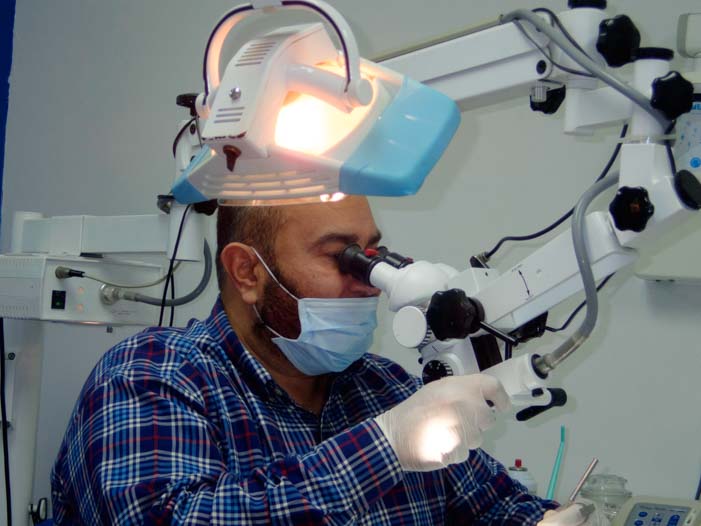
Dr. Avila had very modern equipment with x-rays that went directly to a computer screen, etc., etc.
When I got out of the chair, he explained that I needed anitbiotics and anti-inflammatory meds. He described how to take them and wrote up a prescription, handed me an envelope containing prints of my x-rays as well as the images of my root canal in progress, and then he led us to the door.
His assistant asked me my name and wrote it down on a pad. I gave her $230 in American dollars in cash, and she asked me whether I wanted a receipt. Then she took us out to her car and drove us to Liquis Farmacia, a big pharmacy back near the border crossing area. (“Farmacia” is pronounced “far-MAH-seeya” even though it doesn’t look like it).
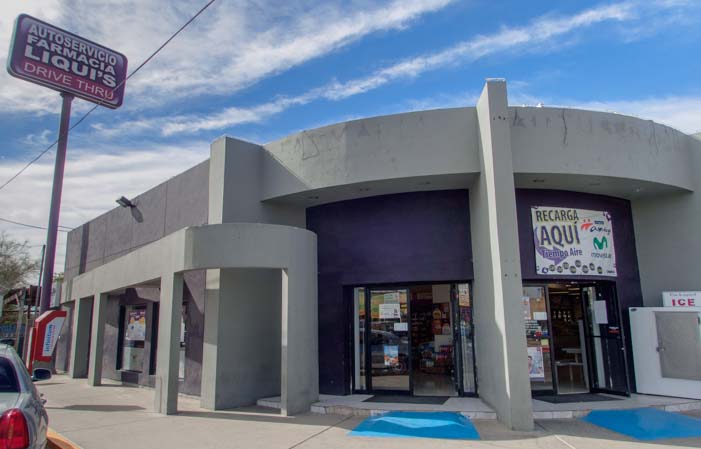
Liquis Pharmacy (“Farmacia”) is a block away from the border.
She took us through the drive-through lane, placed the order for the meds at the window for us, and passed our cash through to the clerk (we paid in pesos, but dollars would have been fine too). It was about $10 for a supply of amoxicillan (Ampliron) and anti-inflammatory Supradol. Then she drove us to Dr. Bernal’s office.
We tipped her $5 in American dollars for driving us around town and making sure we had the right meds in hand before we left the country.

Dr. Avila’s assistant drove us to the drive-through window and ordered my meds for me.
We walked over to Dr. Bernal’s office and I climbed back in his dentist chair (gosh so many times in and out of dentist’s chairs in one morning!!). He took a look at Dr. Avila’s work and said he would complete the job by putting a filling in the crown where Dr. Avila had drilled through to do the root canal. But he didn’t want to do it until a few days had passed and the tooth was totally pain free.
So he sent us on our way (and again, did not charge us a cent).
It was 10:00 in the morning when we crossed back over the border into the US and got back in our truck.
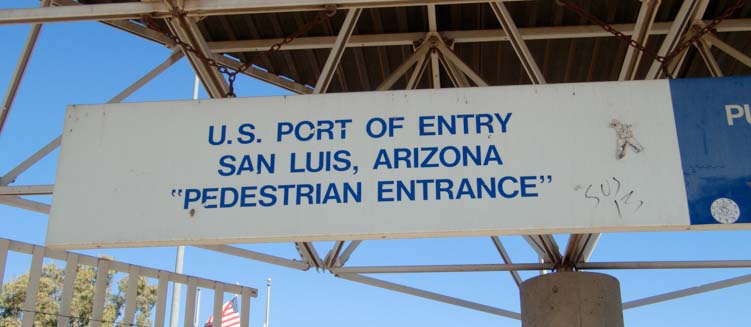
The pedestrian crossing going back into the US
The whole thing had taken an hour and a quarter — with no appointment. In that short span of time we received two check-ups, a diagnosis, a root canal, x-rays and meds.
Including the cab ride from the dentist to the endodontist, a tip for the assistant who drove us to the pharmacy in her own personal car, and the parking fee for our truck that was waiting for us on the American side of the border, it all came to a grand total of $241 US.
So far, we hadn’t paid Dr. Bernal a dime, yet he had masterminded the whole thing.
Does this sound like American dentistry?
We returned a few days later to check in with Dr. Bernal (no appointment, we just walked in). My tooth was still a little tender, so he told me I wasn’t ready for him to do the filling in the crown yet yet. So I was in and out of the chair once again! And again, he didn’t charge me for the checkup.
Finally my tooth was back in action and pain free, so we crossed over the border to Mexico again. This time we went to the endodontist, Dr. Avila, first to get a final x-ray of the root canal and verify that everything was A-okay. He was happy to see me and said everything looked great and sent me on my way. He didn’t charge me for the x-ray or the office visit.
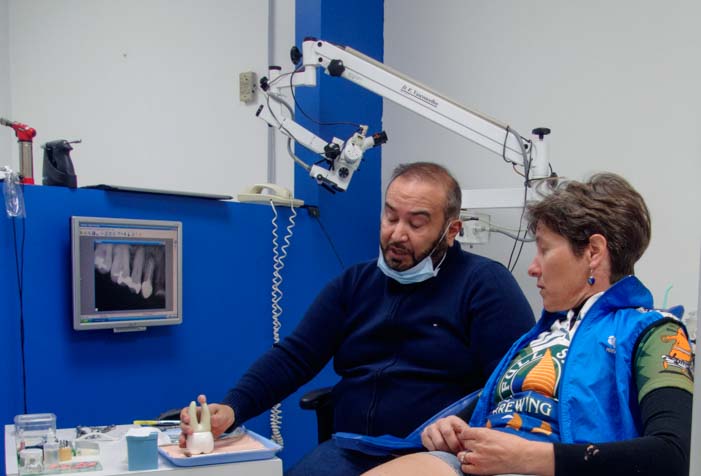
Dr. Avila explains to me about teeth and roots. The x-ray is on the computer screen on the wall.
Then we stopped in at Dr. Bernal’s office. He had a line of patients waiting this time, so we took a seat and waited with them. I got chatting with an American woman next to me, and she told me she and her family had been coming down from Phoenix to see Dr. Bernal for 25 years.
“He must have been just out kid out of dental school back then!” I said.
“We were all a lot younger back then,” she laughed.
Suddenly, an old, hunched Mexican woman came in clutching her mouth. She was moaning as she took a seat. Mark asked her in broken Spanish if she was in pain, and she nodded and rubbed her fingers along her whole lower jaw, obviously in agony.
We were next in line now, but we got up and stuck our heads into Dr. Bernal’s office where he was working on a patient and told him we’d be back later and to please take care of this old woman first.
We wandered around town for a while, and when we returned the woman was gone and Dr. Bernal was free again. I hopped in the chair, and after a few quick zips with the drill, he was done filling the hole in the crown. Then he did a full check on the rest of my teeth and polished some of my white fillings that had started to leach and turn a darker color.
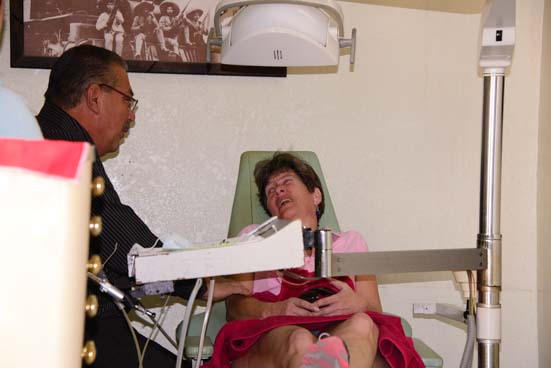
Back in The Chair with Dr. Bernal.
He charged me $40 US. This $40 fee covered the three times I had sat in his dentist’s chair over the past few days since we first crossed the border as well as putting a filling in the crown where the root canal was and polishing me teeth. We handed him the cash, and went back to the border half a block away.
Easy peasy!!
So, my entire procedure involved sitting in dentist’s chairs five times for check-ups and procedures, x-rays, a root canal performed by an endodontist, a filling performed by a general dentist, cab rides between dentist’s offices, antibiotics and pain medications, a tip for the dental assistant who drove us across town and took us to the pharmacy, and the parking fee for our truck waiting for us on the American side of the border.
The grand total for my root canal plus all that other stuff was $281
Tips for RVers Crossing the Border to San Luis Mexico for Dental Care
Yuma is 23 miles north of the US/Mexican border, so it is very easy for RV travelers to get dental work done in Mexico at the San Luis border south of Yuma, AZ. Allow about 35 to 45 minutes to get to the border (it’s mostly highway).
There are loads of RV parks of every description in and around Yuma, and Yuma is a fun town to visit anyway. There are some pretty buildings in the Old Town neighborhood, a really funky burger/bar scene in town at Lutes Casino, and an interesting glimpse of how the Wild West used to be for the bad guys at the Territorial Prison.
For RVers who want to be a little closer to the border and don’t mind dry camping in their trailer or motorhome, Cocopah Casino is 16 miles from the border and has a paved parking area out back that is striped for RVs. As of January 2016 the cost to stay there was $10 for 3 nights. It was very busy when we were there in late January, and I imagine the place is quite packed through the winter season.

There are tons of RV park options in Yuma. At Cocopah Casino there is dry camping as well.
In Mexico’s border towns like San Luis, you can do all financial transactions in US dollars. Some businesses, like Liquis Farmacia (the pharmacy Dr. Avila’s assistant drove us to), will take a credit card, but in our experience most dentists and doctors prefer to be paid in cash (some don’t even have credit card machines in their offices).
If you want to get some Mexican pesos, there are money exchange shops on both sides of the border. But you certainly don’t need to.

There are money changing shops on both sides of the border, but US dollars work just fine.
Take lots of $1 bills for cabs and tips.
Walking over the border is easy, and if you are finished in San Luis early in the day, the walk back over the border is easy too. There was no one in the pedestrian line going back into the US when we got there at 10 a.m.
Later in the day, the border crossing into the US gets much busier. Walking back over the border late in the afternoon can involve a long wait in line for pedestrians (and much much longer for cars). Riding our bikes, we never saw anyone in line at the Sentri Gate.
For us, in all our travels and dental office visits in Mexico over the past eight years, figuring out which dentists to go to has been a matter of talking to the locals and to fellow travelers and to ex-pats who live in the area.
We first heard of Dr. Bernal from RVers staying at the Escapees Kofa RV park in Yuma. Some places with lots of ex-pats have online forums where local dentists are discussed and referred, and that’s how we found two of our favorite dentists in southern Mexico.
Some quick tips:
- You need a passport to return to the US from Mexico
- Take lots of $1 bills for tips and cabs just in case you want or need to be driven around town
- Change will not be made with American coins, just bills. Take a variety of bills to avoid making change in general.
- Some dentists and doctors will take credit cards, but not all. We carried about $350 in cash.
- Bigger pharmacies will take a credit card. Unlike most stores in the US, Liquis was set up for the new chip style credit cards!
- To save on currency exchange fees, get a credit card from Capital One. They waive the standard 3% currency exchange fee
- If you bike over the border, you can save a lot of time getting back into the US because no one uses the Sentri pass / bike gate
- Make a day of it. Go to El Parianchi (10th St. and Obregon) for some awesome food and a truly authentic Mexican experience, especially on a busy Saturday
Here is a Google Maps link for the locations of things in San Luis, Mexico. In this map link, the locations are:
- Dr. Sergio Bernal – showing as “Calle 1 115”
- Liquis Pharmacy – showing as “Calle 1 7”
- Dr. Horacio Avila – showing as “Madero 1307”
- El Parianchi restaurant – showing as “El Parianchi” at 10th St. and the border road.
You can see the location of the town square “Plaza Benito Juarez” too.
Mexican Dentists we recommend:
Here are some of the dentists we have been to and that we would return to. One thing that can be confusing about Mexican names is that the Spanish convention is to give your mother’s maiden name as part of your own name, at the end. So, you state your name like this:
First-name Father’s-last-name Mother’s-father’s-last-name
So “Pedro Diaz Hernandez” would be called “Pedro Diaz” using English conventions.
San Luis (south of Yuma, AZ)
Dr. Sergio Bernal does general dentistry and is located about 1/2 block over the San Luis Arizona/Mexico border on the left hand side in an alcove marked with a large sculpture of a tooth under a sign, “Family Dental” on 1st Street (“Calle 1”) just north of Obregon as described in detail above in this article. Call him directly from the US by dialing this number: 011 52 653 534 6651
Address: First St. #118-9 San Luis Rio Colorado, Mexico. Open Monday-Friday 9-5, Saturday 9-2, Sunday 9-11
Dr. Horacio Avila is an endodontist located at 13th Street (“Calle 13”) and Madero (address is 1305 Madero). He did a root canal for me in 2016 as described above in this article.
Loreto (Baja California Sur – Sea of Cortez)
Dr. Aldo Velásquez works with his father Dr. Eduardo Velásquez at #53 Benito Juarez Street in downtown Loreto. In 2011 Dr. Aldo Velazquez filled a cavity in one of my teeth and checked Mark’s teeth for 450 pesos. At the exchange rate of the time, this was about $40. We went to his office because we passed it on the street while out walking and it appeared well kept and attractive. Later we found out that Aldo and his father are very highly regarded in town. I wrote about our experience in HERE at this link
Zihuatanejo (Southern Pacific coast of Mexico)
In 2013 Dr. Oliverio Soberanis (#210-E 5 de Mayo Ave.) replaced several large fillings in my teeth and fixed some work that had been poorly done by an American dentist long ago. See some pics HERE at this link. I found him by reading an ex-pat forum for Zihuatanejo. He had brand new equipment with TV screens showing the work in progress. I had a cruising friend who is a retired dentist check his work afterwards, and he was very impressed that he took the time to polish the fillings, something many American dentists don’t do because it takes extra time.
Huatulco (Southern Pacific coast of Mexico)
In 2012 Dr. Francisco Hernandez (Sierra de Ixtlan, Edificio B Dept 101, Conjunto Residential Los Mangos) did 2 cleanings for us (550 pesos, or about $45, each) and 3 replacement fillings (450 pesos, or about $35, pesos each) for us as well. The cleanings were the most thorough we’ve ever had, taking about an hour each. He was gentle and very conscientious. We went to him because the dentist that had been recommended in an ex-pat forum was on vacation, and she had left a note on her door giving Dr. Hernandez’ name and address. Another cruising friend (whose boat appears at the top of all our blog posts from Huatulco had an excellent experience with getting some fillings replaced by Dr. Hernandez as well.
If you have been enjoying your RV down near the Mexican border this winter and have been on the fence about whether or not to get some dental work done south of the border, hopefully our stories and info here will help you decide to give it a try.
Typical Costs of Mexican Dentistry and Where It’s Cheapest
Mexico has lots of dentists and doctors practicing all over the country. After all, Mexico’s population is nearly 1/2 of America’s population, and all those people need medical and dental care, just like Americans do!
Because of the big difference in the cost of living between the two countries, Mexican dentists are well aware that their services are sought after by Americans because it’s cheap.
Mexican Dentists Whose Practices Serve Primarily Mexicans Are The Cheapest
Most Mexican dentists set up practices in predominantly Mexican communities, and they charge prices their patients can afford. Their prices are typically 10% to 15% of the costs for identical dental procedures done in America.
San Luis is such a community, even though it is a border town. A few Americans cross the border to get dental work and medical procedures done in San Luis, but they are a smaller percentage of the dentists’ and doctors’ total patient base than in other locations.
In San Luis, Mark’s porcelain crown cost $130 US in 2008. At that time, in America, the cost for a porcelain crown was typically $1,000. My root canal in 2016 plus medications, cab fees and parking fees cost $281. At that time, in America, the cost of a root canal in a tooth that had a crown on it already was typically $2,000 or more.
Mexican Dentists Whose Practices Serve Primarily Americans Are More Expensive
In contrast, dentists that are located in places where Americans tend to congregate often establish their practices specifically to serve Americans. After all, they can make a lot more money that way than by serving Mexicans. This means that they have flashier office space, they have marketing geared towards Americans that is in English, both of which Americans appreciate, and they have higher prices.
Their services may not be any better than the Mexican dentists who focus on Mexican patients, but it will feel more like dentistry “back home” in America. They may require that you make an appointment in advance, they may accept a credit card for payment, and they may speak very fluent English.
The prices in these kinds of places are typically 40% to 50% of the costs of equivalent procedures in America.
One area that is extremely oriented towards Americans is Los Algodones near the border of Yuma, Arizona. Los Algodones is a tiny handful of tightly packed streets that are wall-to-wall dental and medical offices that serve an entirely American clientele. Few, if any, Mexicans go to these dentists and doctors for care. It is way too expensive for them.
Likewise, we found in our cruise along Mexico’s west coast that the dentists who operated in the more central and touristy parts of any town tended to have more American style facilities and higher prices.
In Ensenada, a cruise ship destination 70 miles south of San Diego, a dentist on the “front side” of town greeted us wearing scrubs (you rarely see that in more Mexican-oriented dental offices). He spoke perfect English and gave us a quote for a very American sounding price for a simple cleaning and a filling.
We decided to pass on his services. However, during our stay in Ensenada, we got to know the affluent looking owner of an ice cream shop in town and asked him for a recommendation for a dentist. He sent us to a totally different part of town where a very skilled dentist in a much simpler office took care of us at the typical 10% to 15% of American prices that “Mexican dentists for Mexicans” charge.
So, when looking for a dentist in Mexico, keep in mind that dentists whose patients are primarily American will charge you prices that are much higher than dentists whose patients are primarily Mexican. Whether the actual dental care they provide is any different is truly debatable. It’s just more expensive and feels more familiar because of the outer trappings of the office space itself and the way they run their business.
Map showing Los Algodones and Yuma, Arizona
Make a day of it and HAVE SOME FUN between Doctor and Dentist visits in San Luis!
Crossing the border on foot forced us to rely on taxis to get to the more distant locations on the other side, so after our first visit, we decided for future trips it would be a whole lot easier and more interesting to ride our bikes over the border instead. We simply parked our new truck on the American side for the day, unloaded the bikes, and walked them across.
Once on the other side we could get around town quickly and easily.
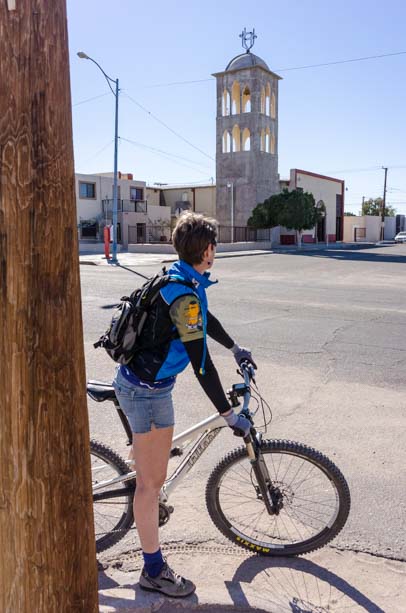
We found riding our bikes around San Luis was much more fun and made the border crossing back to the US easier.
And that’s when we really started to have some fun too.
Mexico is a vibrant country with really exuberant, fun-loving people. Everybody is outgoing and friendly and warm, and we have always found it really enjoyable to chat with people on the street, whether in our halting Spanish or in their typically very good English.
Like all Mexican towns, there is a town square in San Luis that is lined with palm trees and has a bandstand at the center. It wasn’t quite as festive as the one in Guanajuato or the town square in Oaxaca, but it we enjoyed wandering through it.
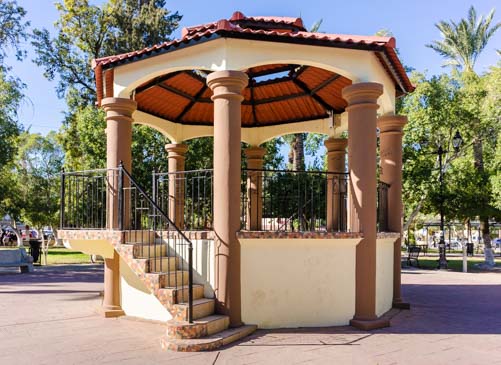
The town square/park named for Benito Juarez has a small band stand.
We really enjoyed seeing San Luis beyond the dentist’s office. There’s plenty of security too — we saw police riding around on Segways (how fun!). They very kindly came over to offer assistance when we looked a little lost at one point.

Now there’s a great way to get around town!
There are lots of places to eat, and if you find yourself in town waiting between dentist or doctor visits and need a bite, there is a Subway that makes sandwiches exactly the way we’re all accustomed to. The only difference is the menu is in Spanish. But don’t worry, the workers will take your order in English — and if they struggle, sign language and pointing at what you want always helps.

Subway has a shop in town, and the only difference we found was the Spanish words on the menu.
Pointing and smiling works fine if you can’t make out the Spanish words.
If you have a little more time, check out El Parianchi, a fabulous restaurant that is the Real Deal for Mexican food, Mexican flair and Mexican fun. We LOVED it there.
We found El Parianchi one day when we were looking for the other top restaurant in town, El Herradero where we had enjoyed some chips and salsa and beer on an earlier visit. We were a little lost, though, and we found ourselves in front of El Parianchi instead. When we asked the parking lot attendant, Fernando, for directions to El Herradero, he talked us into staying at El Parianchi, because the food there was truly delicious.
“I’ll put your bikes in here,” he said, pointing to a locked shed in the back of the restaurant. “They’ll be safe.” Deal! We rolled them in between the rakes and shovels and barrels, and went on in.
We had been noticing that we were the only gringos in the whole town. And now we were very definitely the only gringos in this restaurant. We were also the only people dressed in cycling clothes.
Talk about standing out!
It was a Saturday afternoon, and the place was hopping. Waiters rushed here and there, grabbing extra tables and chairs for people, and the food was flying out of the kitchen at a wild rate.

The servers were hustling at El Parianchi on Saturday afternoon!
Two big parties — what looked like a baptism party and an engagement party — were in full swing at long tables on either side of the restaurant, and a Mariachi harp player was singing and strumming his heart out in a corner.
People were laughing and eating and have a grand time while the waiters ran at top speed from one end of the room to the other.
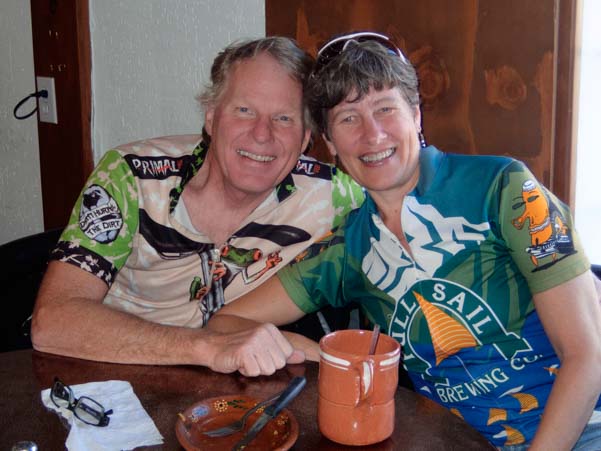
Gringos in cycling jerseys. Sure…we blend right in!
We were seated to one side, and in an instant, a waiter was at our table welcoming us.
We both ordered Corona with a lime, and Mark got a bottled water and I ordered a Jamaica water as well. Jamaica water is an absolutely delicious drink make of hibiscus flowers that has a tartness like cranberry juice (and is about that color) but is much sweeter. Jamaica is pronounced “Hamikah” with a long “i” (even though it doesn’t look like it), and it is a refreshing drink I enjoyed repeatedly throughout our Mexico cruise.
The drinks arrived along with tortilla chips and a bean dip that was to die for. If only I could make beans like that!
Suddenly the harp Mariachi player appeared at our table. Mark handed him a few dollars and asked for a song.
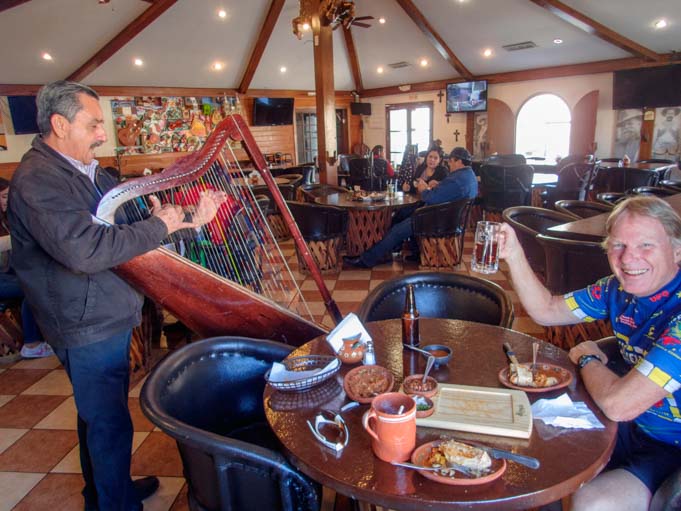
A harp playing Mariachi sang some songs for us — what total fun!!!
“What song do you want?” the harpist asked.
After racking our brains to remember the name of a Mexican folk song, we came up with “Alla En El Rancho Grande!”
He proceeded to play a great rendition of it. I don’t have a video of him singing, but I do have a special video of another Mariachi singing this exact same song for us when we were in Huatulco Mexico at a little beach bar in the sand. Our sailboat Groovy was anchored just out of sight.
When he finished the song, the folks at the tables around us clapped. He wanted to sing a second song for us, so we asked for Mariachi Loco. This is a really cute song we first heard on a day charter catamaran called Picante that used to circle past our boat at anchor in Zihuatanejo.
We were having so much fun in this restaurant, we hadn’t even looked at the menu yet!
Suddenly, the manager, Jose, came over and asked if we were having any trouble understanding the menu. We told him we wanted a beef and bean burrito, and he recommended one of the “percherones.” We’d never had one before, but the “Sonorense” was absolutely scrumptious. It was so good, in fact, that we came back another day just to sample it again!!

For a genuine Mexican culinary experience, check out El Parianchi on 10th Street and the street along the US/Mexico border by the international boundary wall.
When the bill came, it was $17.73 US including our 20% tip — and we had plowed through four beers, a bottle of water, my Jamaica water, our chips and bean dip plus the huge percheron burrito we had split.
We got up to go, rubbing our aching tummies, and suddenly a waiter was carrying over two huge sombreros for us.
We put them on and cracked up.
The harp player placed his harp in front of us, and Jose took pics of us while everyone at the big party at the long table clapped and laughed. How fun!

Olé!!
Then someone handed Mark a guitar and he strummed a few chords.
What a total blast this was!

Mark finds a guitar in his hands and a sombrero on his head!!
We left to a chorus of cheers and found Fernando waiting in the parking lot. He unlocked the shed door and helped us disentangle our bikes from the rakes and shovels and buckets inside. We tipped him a dollar for his efforts.
Rolling back to the border on our bikes, we passed dozens and dozens of cars lined up to cross into the US. By now the pedestrian line was really long too.
In San Luis, bicycles go through the Sentri Pass gate (a special gate for people who cross the US border on a regular basis). This was awesome because there was never anyone in line at that gate!!

What a fabulous day… and no line for bikes at the border!
Our smiles went from ear to ear when we settled back in our little buggy after a great day in Mexico.
Note: We returned to San Luis to see Dr. Bernal and Dr. Avila for more dental work a year later in October 2016. Read the blog post here:
A Visit to the Dentist in Mexico
To get the hours of operation of the San Luis, Arizona, USA / San Luis Rio Colorado, Sonora, Mexico border crossing and other info, call: 928-627-8854
Subscribe
Never miss a post — it’s free!
Our most recent posts:
- How to Install Starlink Gen 3 in an RV? Use the Speedmount! 08/07/25
- Escape to Paradise – Rocky Mountain Magic! 08/01/25
- Is Forest River a Good RV? Well Built? Here’s Our Experience 06/20/25
- Sunset Crater Nat’l Monument – Lava & Camels at Bonito CG! 06/06/25
- 2024 Alpha Wolf 17CB Trailer – Our Goldilocks RV! 04/25/25
More of our Latest Posts are in the top MENU above.
For more info from other RVers who have gone over the border to get dental care, see the following two blog posts by Nina Fussing of WheelingIt HERE and HERE.
Related Articles from our experiences in Mexico
- Is Mexico Safe? – What we found out
- And God Said, “Let The Beer Flow!” – In Mexico, Easter (“Semana Santa”) is one big, happy party!
- It’s Not About The Hair! – A simple haircut in Mexico offers a unique glimpse of Mexican culture
- Celebrating a Mexican 15th Birthday — On Our Boat! – Our boat “Groovy” gets swept up in a fabulous coming of age party!
- “Divorced Eggs” On My Plate – What’s THAT On The Menu??!!
<-Previous || Next->
Below are some of our most POPULAR POSTS (also in the MENUS above)
Buddy - A Journey in Spirit - The story of an event that changed our lives forever. ARTICLE INDEXES- RV Tech Tips Articles - A one page index of links to all our RV Tech Tips, RV Upgrades & RV Maintenance articles.
- RV Lifestyle Tip Articles - An index of links to all our RV Lifestyle Tips (finances, boondocking, major repairs, work/jobs, etc.)
- Solar Power Articles - Overview and tutorial articles for how to design and install solar power on an RV or boat
- Product Reviews - An index of links to all of our Product Reviews
- Basic RV Tool Kit - What tools do RVers need? Here's a list of essentials, from tire changing to electricity, plumbing & more
- RVing Tips & Tricks - Tips and tricks to make RVing easy
- Reese Goose Box - Reclaim your TRUCK BED with air ride smooth towing + How to hitch and unhitch!
- RV Heater Installation - Step-by-step guide for how to select and install a vent-free propane heater
- CargoBuckle Ratchet Straps - These retractable straps make it a CINCH to tie down a side-by-side, motorcycle or ATV
- How to change a dually truck's inner rear tire - Tips for changing the inner rear tire on a dually truck.
- EASY SOLAR POWER UPGRADE - We TRIPLED our factory installed solar power output for CHEAP
- B&W Fifth Wheel Hitch - Why we chose this hitch for our fiver plus an easy 5th Wheel Hitch Installation Guide.
- Demco 21k Recon Fifth Wheel Hitch - This fifth wheel hitch mounts on a gooseneck ball in the truck bed!
- Increase Your RV Storage Space - Add precious storage space at the RV dinette with storage benches!
- Buying a Truck - Which options turn an ordinary diesel pickup into a massive TOWING MACHINE?
- Battery Charging Primer - The low-down on RV and marine batteries and how to charge them effectively.
- Which Solar Panels are Best? - Which is better: FLEXIBLE or RIGID?? 12 or 24 volt?? monocrystalline or polycrystalline???
- RV Solar Power Made Simple - An overview of how solar power works on an RV
- Trailer Disc Brake Conversion - Massively improve trailer stopping power with electric over hydraulic disc brakes
- Truck Engine Upgrade - How we improved performance, towing power and fuel economy with an engine tuner
- How to Defrost an RV Refrigerator in 20 Minutes - It is actually a cinch to defrost an RV fridge!
- Solar Charge Controllers - Understand and OPTIMIZE your RV / marine battery solar charging
- Wet Cell vs. AGM Batteries - Which is better, why we upgraded, PLUS wiring tips to optimize battery life
- Suspension Overhaul on a 5th Wheel - A Total Re-design for our Suspension: Hangers, springs, shocks & more!
- Can you run SOLAR POWER and SHORE POWER together? - What happens when you're on solar and you plug in?
- Converters, Inverter/Chargers and Engine Alternators - How do these battery charging systems REALLY work?
- RV Budget, Costs and Expenses - A detailed analysis of RVing expenses over 7 years of RVing full-time
- RV Extended Warranties - Is an RV warranty a good investment or a waste of money? Our personal case history.
- Working and Living on the Road - How do you make money on the road and who lives this nomadic lifestyle?
- Sell or Lease the House? - Is it better to SELL or LEASE your house when you start a life on the road?
- Mexican Dentists - Are the Dentists in Mexico any good? Just how cheap are they? Here are our PERSONAL experiences.
- How An RV Warranty Saved Our Bacon - Literally! - One repair on our RV practically paid for our RV Extended Warranty
- Still Smiling After 3 Days at the RV Repair Shop - Why? Our RV Warranty put us $2,000 ahead of the game!
- 5th Wheel Suspension Replacement - When our trailer's suspension failed, we $aved $$$ Thousands getting it replaced.
- RV Toilet Replacement - Our RV toilet quit flushing (ugh!) but our RV warranty saved us again. Now we're $6,700 ahead!
- RV Boondocking - Tips for how to live in an RV off the grid
- Which RV Is Best for Full-Time Living? - Transitioning from a house to an RV - Which RV makes the best home?
- Truck Camper Pros and Cons - The GOOD, the BAD and the UGLY!
- Full-time RV Lifestyle Tips - Full-time RVing Logistics - Mail, Domicile, Insurance, Warranties, Saving Money at RV Parks
- Toy Hauler Life - What's it like to live in an OPEN BOX Toy Hauler?
- What are the MOST IMPORTANT FEATURES in a Full-time Fifth Wheel? - For anyone planning to live in an RV!
- Internet & Phone Access for RVers - An inexpensive, minimalist solution for internet access on the road
- RV Dump Stations & Composting Toilets - How to do the dirty deed at the RV dump PLUS RV Composting Toilet tips
- Choosing a Trailer for Full-time RVing - Why the payload capacity is so important
- Learn RVing the Fun Way!! - Go Cheap, Go Small, Go NOW and have a blast in little RV!
- Free RV Campsites - Resources for locating campsites for boondocking
- Glimpses of the Full-time RV Life - Anecdotes from the road and essays about living the RV dream.
- Travel Photography Tips! - All the cameras, gear, books, blogs and tools we used to learn to take great pics!
- Gear Store - A list of the goodies, equipment and gear we've found useful in our RV lifestyle!



